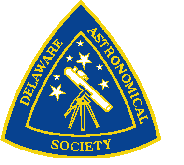

|
Don Shedrick |
May, 2001 |
May DAS Focus
COMPUTERS IN ASTRONOMY by Don Shedrick
There are a lot of Internet sites providing various news items about space or astronomy, but one of the most extensive ones I have recently come across is a site run by the Houston Chronicle newspaper. The Space Chronicle at:
http://www.chron.com/content/chronicle/space/index.html
has an excellent assortment of current news articles about space, astronomy, and a particular emphasis on space missions. What sets this site apart from the crowd is the large selection of videos of present and past space missions. For the recent shuttle mission, the site has videos of lift off, landing, and highlights from each day in flight. In addition, the site provides a live streaming video feed of NASA TV, which has a constantly changing variety of timely presentations of NASA news and missions.
If you would like to try to visually sight the space shuttle or International Space Station passing overhead, go to the NASA Human Spaceflight site at:
http://spaceflight.nasa.gov/realdata/sightings/index.html
which has NASA’s SkyWatch, a Java applet that uses up-to-the-minute data from Mission Control to project the path the spacecraft will make across the sky. There is also a quick sighting by city (which lists Philadelphia) to get a quick text based report on available sighting opportunities.
The summer skies will be dominated by Mars, which is gearing up for its best observing opportunity in a decade. Mars rises at midnight early in May and by 10 p.m. at month's end. Earth is overtaking Mars in the race around the sun. Mars will appear to move to the east, or retrograde, against the stars, reaching the constellation of Sagittarius on May 11. Mars then resumes its normal, westerly course, ending the month in Scorpius. As Earth and Mars close the gap between them, Mars will grow in apparent size and brightness in our telescopes until by the end of June, it will appear slightly larger than Saturn did during its recent display.
Although Mars is bright, details are hard to see on the planet with a small telescope. But with patience and practice, many subtle details become visible.
MarsNews.com has partnered with the Open Directory Project to offer Internet users the Mars Open Directory, a collection of the best Mars websites. It can be found at:
http://www.marsnews.com/directory/
At the Roving Mars Atlas web site:
http://www.roving-mouse.com/planetary/Mars/Atlas/
Point at the globe of Mars to see large feature names. You can rotate the globe to view the other three hemispheres, and Click to view a color closeup. Point at closeup to see the names of small features like craters. Click to zoom in to an even higher resolution map at USGS.
It helps to know what to look for in observing Mars, and in particular what side of the planet is facing earth at your observing time and what features would be visible. Since the Martian day is only slightly more than Earth’s, it takes over a month for the side visible from earth to complete one rotation if viewed at the same time each night. There are several web sites or programs that provide information on what side of Mars is facing us.
Mars Previewer II is a very impressive program for Mars watchers written by Leandro Rios, an amateur astronomer in Argentina. This displays the central meridian, phase, magnitude, and angular size of the red planet for any date and time. It is available as freeware on the Sky and Telescope web site:
http://skyandtelescope.com/resources/software/article_328_1.asp
Mars Today, created by Howard Houben of the Mars Global Circulation Model Group, is a poster produced daily by the Center for Mars Exploration (CMEX) at NASA's Ames Research Center. The poster at:
http://humbabe.arc.nasa.gov/MarsToday.html
depicts current conditions on Mars and diagrams the current positions of Mars and Earth in their orbits around the Sun. There is also animation of the orbits of Earth and Mars through 2000 and 2001 showing their relative positions and tilts of their rotation axes that are responsible for the seasons.
The images of Mars from the above software programs will take on more meaning if you use a more detailed map to identify the Martian features. The Association of Lunar and Planetary Observers has a detailed Map of Mars on line at:
http://www.lpl.arizona.edu/~rhill/alpo/marstuff/Mars2000.jpg
with all major features and degrees of longitude labeled.
Much more Mars info, including news, Mars missions, maps and atlas, landing sites info, and many images are provided at The Center for Mars Exploration site at:
This summer when you are hot and sweaty, get a refreshing glimpse of the latest chilly Martian Weather Observations from the Mars Global Surveyor Radio Science Team. They are posted regularly on the site:
http://nova.stanford.edu/projects/mgs/dmwr.html
Have a great summer!